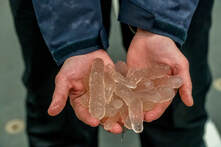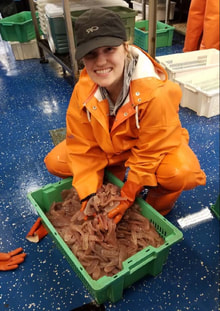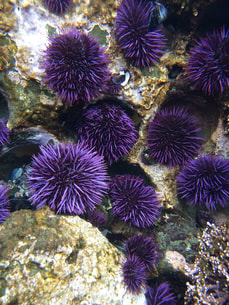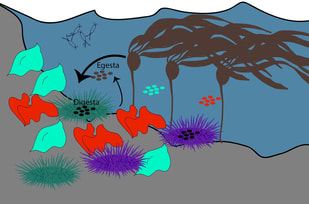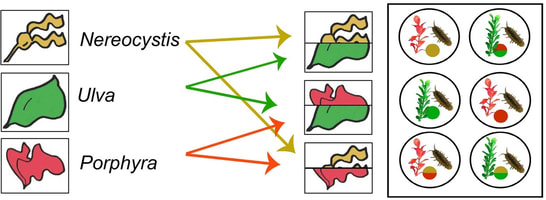Here are a few summaries of recent projects in which I have used fatty acids (lipid building blocks) and food web biomarkers to trace what organisms are eating and get a better idea of food quality. For more detailed information, please check out the publications link for published projects or contact me for more information about on going projects.
Pyrosome abundance, distribution, and feeding ecology
|
During 2016−2018, there was an unprecedented aggregation of colonial pelagic tunicates known as pyrosomes (Pyrosoma atlanticum) or 'fire bodies' due to their ability to bioluminescence. These dense aggregations of pyrosomes were observed in the Northern California Current (NCC) along the western coast of the United States. Pyrosomes are common in tropical and sub-tropical ocean waters, but little is known about their abundance, distribution, and food web ecology in mid-latitude systems.
To better understand more about the dynamics that influence pyrosome abundance, distribution and food web ecology, Hilarie Sorensen collected pyrosomes during cruises in the NCC in May and August 2017. The results of this project were included in her Master's thesis at the University of Oregon and the results focused on the pyrosome abundance, distribution, and feeding ecology (through the use of tissue biomarkers - fatty acids and stable isotopes) were recently published. Briefly, our results indicate that sea surface temperature and surface salinity were important variables related to pyrosome densities. Also, common FA markers for bacteria, carnivory, and dinoflagellates differed by latitude, suggesting that pyrosomes have different diets over a fairly broad latitudinal range. The δ15N values of P. atlanticum indicated that pyrosomes may be feeding at a relatively low trophic level compared to other zooplankton groups in this region. Offshore pyrosomes had lower δ13C values than those collected on the shelf, suggesting incorporation of nearshore carbon in pyrosome tissues. Previously documented rapid reproduction and growth of pyrosomes coupled with efficient feeding behavior for common NCC plankters may support their continued presence in this mid-latitude region. |
Purple sea urchin feeding ecology and subsidies
|
Purple sea urchins (Strongylocentrotus purpuratus) are abundant and charismatic inhabitants of the intertidal and subtidal zones of northeast Pacific Coast, including the Southern Oregon Coast. The purple urchins of the Southern Oregon Coast can often be observed at low tide, inhabiting burrows. Sea urchins in general can play many roles in structuring marine communities from creating ‘urchin barrens’ to contributing nutritional subsidies or environments that promote development of local biomass and diversity. Urchins can make food available to organisms that feed on particulate matter because they are messy eaters and they minimally process consumed seaweeds in their guts (digesta), resulting in production of nutritious fecal pellets (egesta).
Fatty acids (FA) have been used as trophic biomarkers to investigate food web dynamics, particularly between primary producers and primary consumers. Because the purple urchins in intertidal burrows can obtain food by either foraging or catching loose drift seaweed (or some combination of the two) in the Coastal Trophic Ecology Lab (CTEL) we have begun our investigation of teasing out the relative importance of these two feeding modes by performing controlled feeding experiments. We have investigated the nutritional value of seaweed (using a brown, a red, and a green species) before they are consumed by urchins, the nutritional value of urchin gut contents (digesta), and fecal material produced (egesta). In these experiments, we have documented the FA profiles of the foods the urchins consume, the urchins themselves, urchin fecal material and a ‘secondary’ consumer raised on urchin fecal material. |
Isopod feeding ecology
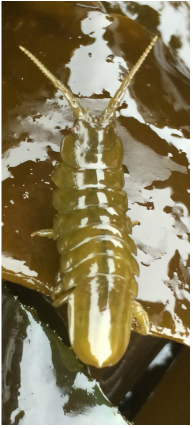
Benthic primary consumers represent an essential link between macroalgae and secondary consumers. Biomarkers such as fatty acid (FA) profiles can be used to investigate trophic relationships and interactions. The isopod Idotea wosenesenskii (pictured left) is a primary consumer that is being raised on pure macroalgal diets to develop quantitative diet estimates of wild isopods based on fatty acid (FA) biomarkers in the Coastal Trophic Ecology Lab (CTEL).
Isopod FAs have been shown to vary with available algal cover in the field, but not always. There are several potential explanations for this variability, including but not limited to non-trophic drivers, differential incorporation of diet material in tissues, preferential feeding rates, or differential growth rate depending on available food quality. I am interested in evaluating diet influence on isopod tissue turnover, subsequent biomarker incorporation, and coloration in addition to FA profiles, growth, and feeding and molt rates of isopods to get a better idea of organismal conditions and trophic ecology.
To accomplish this, I collected adult isopods and am maintaining them on pure or 50:50 mixed diets of a red (Porphyra sp.), green (Ulva sp.), and brown (Nereocystis luetkeana) alga for sixteen weeks. Experimental diets were generated with freeze dried algae, which were ground to a uniform powder and suspended in an alginate solution to essentially make algae jello, removing structural differences between diets. So far, I have determined that isopods had higher feeding rates for diets incorporating the green and brown algae compared to those with the red.
Body coloration plays an important role in protection against predation. I am also interested in the role substrate vs. diet plays with determining whole body color. To test this, I maintained isopods on the before mentioned diets and placed them on either red or green plastic aquarium plants (as diagrammed below).
Isopod FAs have been shown to vary with available algal cover in the field, but not always. There are several potential explanations for this variability, including but not limited to non-trophic drivers, differential incorporation of diet material in tissues, preferential feeding rates, or differential growth rate depending on available food quality. I am interested in evaluating diet influence on isopod tissue turnover, subsequent biomarker incorporation, and coloration in addition to FA profiles, growth, and feeding and molt rates of isopods to get a better idea of organismal conditions and trophic ecology.
To accomplish this, I collected adult isopods and am maintaining them on pure or 50:50 mixed diets of a red (Porphyra sp.), green (Ulva sp.), and brown (Nereocystis luetkeana) alga for sixteen weeks. Experimental diets were generated with freeze dried algae, which were ground to a uniform powder and suspended in an alginate solution to essentially make algae jello, removing structural differences between diets. So far, I have determined that isopods had higher feeding rates for diets incorporating the green and brown algae compared to those with the red.
Body coloration plays an important role in protection against predation. I am also interested in the role substrate vs. diet plays with determining whole body color. To test this, I maintained isopods on the before mentioned diets and placed them on either red or green plastic aquarium plants (as diagrammed below).
